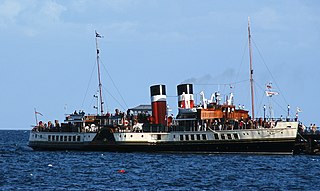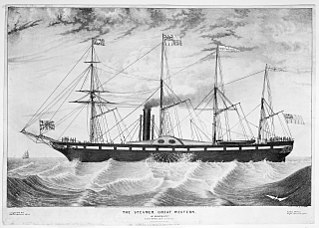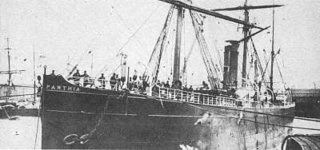
A steamship, often referred to as a steamer, is a type of steam-powered vessel, typically ocean-faring and seaworthy, that is propelled by one or more steam engines that typically move (turn) propellers or paddlewheels. The first steamships came into practical usage during the early 19th century; however, there were exceptions that came before. Steamships usually use the prefix designations of "PS" for paddle steamer or "SS" for screw steamer. As paddle steamers became less common, "SS" is incorrectly assumed by many to stand for "steamship". Ships powered by internal combustion engines use a prefix such as "MV" for motor vessel, so it is not correct to use "SS" for most modern vessels.

An ocean liner is a type of passenger ship primarily used for transportation across seas or oceans. Ocean liners may also carry cargo or mail, and may sometimes be used for other purposes. The Queen Mary 2 is the only ocean liner still in service to this day.

HMS Minden was a Royal Navy 74-gun Ganges-class third-rate ship of the line, launched on 19 June 1810 from Bombay, India. She was named after the German town Minden and the Battle of Minden of 1759, a decisive victory of British and Prussian forces over France in the Seven Years' War. The town is about 75 km away from Hanover, from where the House of Hanover comes—the dynasty which ruled the United Kingdom from 1714 until 1901.

SS Great Western was a wooden-hulled paddle-wheel steamship with four masts, the first steamship purpose-built for crossing the Atlantic, and the initial unit of the Great Western Steamship Company. Completed in 1838, she was the largest passenger ship in the world from 1837 to 1839, the year the SS British Queen went into service.

SS Oceanic was the White Star Line's first liner and first member of the Oceanic-class; she was an important turning point in passenger liner design. Entering service in 1871 for Atlantic crossings, she was later chartered to Occidental and Oriental Steamship Company (O&O) in 1875. The ship provided passenger service for O&O in the Pacific until 1895 when she was sold for scrap.

The Pacific Mail Steamship Company was founded April 18, 1848, as a joint stock company under the laws of the State of New York by a group of New York City merchants. Incorporators included William H. Aspinwall, Edwin Bartlett, Henry Chauncey, Mr. Alsop, G.G. Howland and S.S. Howland.

SS Adriatic was the first of two White Star Line ocean liners to carry the name Adriatic. The White Star Line's first four steamships of the Oceanic-class, the met with great success in the trans-Atlantic market, and the line decided to build two more. The first of these was the SS Adriatic, which was built by Harland and Wolff and launched on 17 October 1871; the second was the SS Celtic.

The Océan-class ships of the line were a series of 118-gun three-decker ships of the line of the French Navy, designed by engineer Jacques-Noël Sané. Fifteen were completed from 1788 on, with the last one entering service in 1854; a sixteenth was never completed, and four more were never laid down.
The Collins Line was the common name for the American shipping company started by Israel Collins and then built up by his son Edward Knight Collins, formally called the New York and Liverpool United States Mail Steamship Company. Under Edward Collins' guidance, the company grew to be a serious competitor on the transatlantic routes to the British Cunard shipping company.

The "Big Four" were a quartet of early-20th-century 20,000-ton ocean liners built by the Harland & Wolff shipyard for the White Star Line, to be the largest and most luxurious ships afloat. The group consisted of Celtic, Cedric, Baltic and Adriatic.

Persia was a British passenger liner operated by the Cunard Line that won the Blue Riband in 1856 for the fastest westbound transatlantic voyage. She was the first Atlantic record breaker constructed of iron and was the largest ship in the world at the time of her launch. However, the inefficiencies of paddle wheel propulsion rendered Persia obsolete and she was taken out of service in 1868 after only twelve years. Attempts to convert Persia to sail were unsuccessful and the former pride of the British merchant marine was scrapped in 1872.

SS Coptic was a steamship built in 1881, which was successively owned by the Oceanic Steam Navigation Company, the Pacific Mail Steamship Company, and the Japanese Oriental Steam Ship Co. before being scrapped in 1926. She was filmed by Thomas Edison in 1897 in one of his early movies. The movie is currently stored in the Library of Congress.

SS Gallic was a cargo steamship built in 1918. During her career, she had six different owners and sailed under the flags of the United Kingdom, Panama and Indonesia. She underwent seven name changes during her 37-year career. She was scrapped at Hong Kong in 1956, the last surviving White Star Line cargo ship.

SS Parthia (1870–1956) was an iron-hulled transatlantic ocean liner built for the Cunard Line by William Denny and Brothers in Dumbarton, Scotland. Her sister ships were the Abyssinia and Algeria. Unlike her two sisters, Parthia was smaller, built in a different shipyard and had a slightly different funnel arrangement. The Parthia was retired by Cunard in 1883 and sold to John Elder & Co., who subsequently transferred her to the Guion Line. After serving with the Guion Line and operating on trans-Pacific routes with the Canadian Pacific Railway Company, she was refitted and renamed Victoria.

The Oceanic class were a group of six ocean liners built by Harland and Wolff at Belfast, for the White Star Line, for the transatlantic service. They were the company's first generation of steamships to serve the North Atlantic passenger trade, entering service between 1871 and 1872.
Several ships have borne the name Caledonia for Caledonia:
Several ships have been named Majestic:
Several vessels have been named Barosa, initially for the battle of Barrosa :

Adriatic was a wooden-hulled, side-wheel steamship launched in New York in 1856. She was conceived as the largest, fastest, most luxurious trans-Atlantic passenger liner of her day, the pride of the Collins Line. At the time of her launch she was the largest ship in the world.














